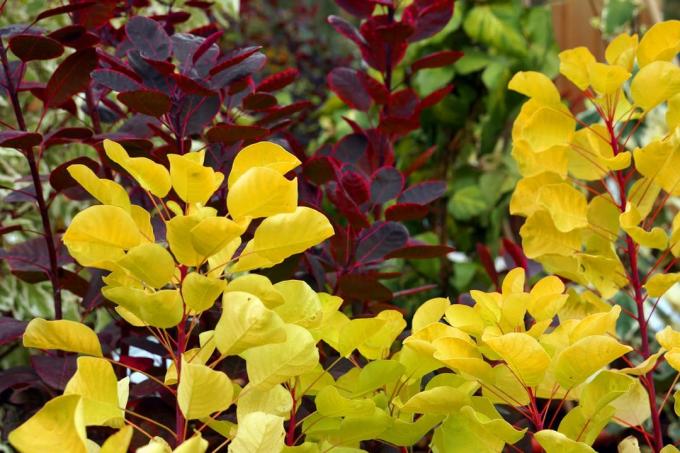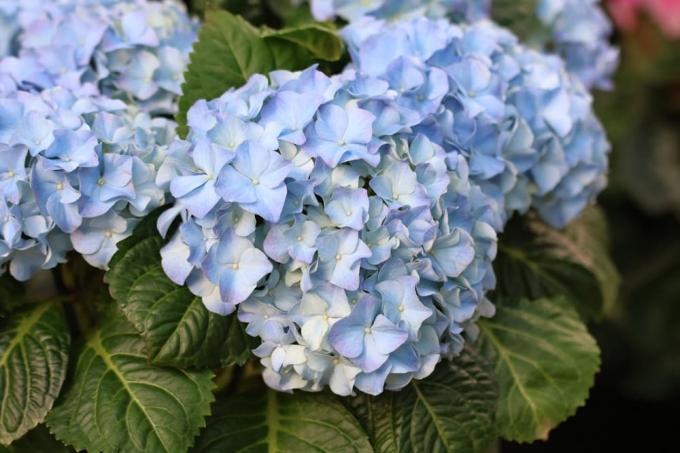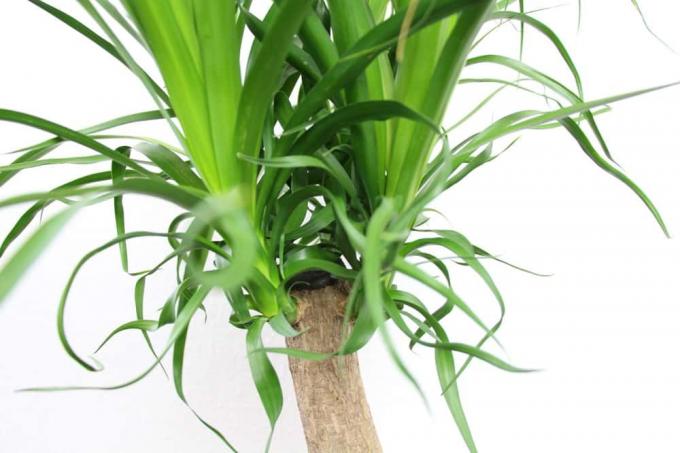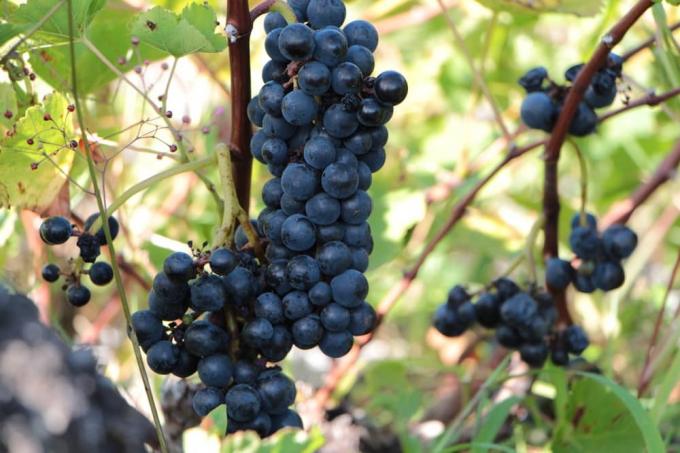

Table of contents
- Unlignified head cuttings
- Unlignified partial cuttings
- Semi-lignified shoot cuttings
- axillary cuttings
- leaf cuttings
Some perennials, especially evergreen species such as knapweed or penstemon, but also perennial foliage plants such as garden rue and dog chamomile, are propagated with head cuttings.
Unlignified head cuttings
From the tips of strong, leafy shoots in late summer or early fall, take cuttings about 7.5-10 cm long, at least three each Leaf knots Cut straight below the bottom leaf knot with a sharp knife or razor blade and remove the two lowest leaves. The cuttings are then placed in a flower pot filled with potting soil or a mixture of one part peat and one part coarse sand; a 10cm pot will hold about six cuttings.
Small planting holes are now drilled into the substrate with a pencil. Insert the cuttings so that the leaves stay above the ground, then press them down with your fingers. Then the substrate is watered well from above, the cuttings are marked and a transparent film is put over the pot, which is fastened with a rubber band. To prevent the cuttings from coming into contact with the foil, it is best to make a frame out of bent floral wire before you put the foil on. The cuttings are rooted in a shady spot in a cold frame or in a propagation bed with a constant temperature of 16 °C.
After 4-6 weeks in the cold frame or 3 weeks in the propagation bed, the cuttings should have rooted. You can check this by gently pulling on the plants. When roots have formed, you can remove or replace the foil. remove the pot from the propagation bed. Finally, very gently pull the rooted cuttings out of the soil and plant them in 3" pots of suitable potting soil.
The young plants are pressed firmly, placed in a shady cold frame and watered abundantly; the irrigation water should be able to drain off well. Pinch off the growing shoot tips of these young plants after about 1 week to encourage vigorous root growth.
Tip:
The plants are kept in a closed cold frame over the winter and are not planted outside until spring, as soon as the danger of frost has passed.
Unlignified partial cuttings
Most perennials with bulbous roots, e.g. B. Ox tongue, delphinium, coneflower, thrift, lupine and scabious can not only be propagated by division but also by young shoots.
To do this, some of the basal, young shoots are cut off about 7.5-10 cm below the base of the leaves. Place these cuttings directly in the cold frame or in 7.5 cm pots filled with a peat-sand mixture.
Spray the cuttings with water from above and keep the cold frame closed at all times. Once the cuttings sprout, start airing for longer and longer periods of time. After about 6 weeks, the cuttings are planted individually in 9 cm pots and outdoors in the fall.
Semi-lignified shoot cuttings
Many shrubs and trees such as ray stalks, orange flowers, bearded beard or lavender can also be propagated by cuttings in summer. Half-lignified cuttings are taken from annual shoots that are already slightly lignified below, but are still in the growth phase and therefore green and not lignified. Such cuttings are taken in mid to late summer. This type of propagation requires little maintenance until it is rooted, since you need a suitable propagation bed and you have to carefully control the water supply and shading. Only after 1-2 years can the plants be placed in their intended location outdoors.
The side shoots of the same year, about 15-20 cm long, are suitable as cuttings. The cutting is cut off with a knife or pruning shears close to the main shoot. Then remove the lower part of the shoot and cut off the shoot below the first leaf node. The large shoot tip is removed above a leaf so that the cutting is 5-10 cm long.
axillary cuttings
Semi-lignified cuttings often root better if you leave a piece of the main shoot attached to them. Some species, such as firethorn, will not develop roots without this "appendage". The axillary tissue promotes root formation because it contains cells that are highly capable of dividing.
First, the main shoot is cut off with several side shoots and, if possible, without flowers, and then cut diagonally below a side shoot with a sharp knife. With the same cut from top to bottom, the side shoot including the axillary tissue is separated from the main shoot. These cuttings should be about 5-7.5 cm long, shorten longer shoots from the top.
Tip:
Plants that are difficult to propagate should be taken from multiple cuttings.
All cuttings, whether with or without axillary tissue, are best rooted in a suitable growing medium, e.g. B. a mixture of peat and sand. A 7.5 cm pot can be used with about five, a 12 cm pot with about ten cuttings are planted.
The cuttings are placed in the substrate up to a third of their length, pressed firmly and watered well with a fine spray attachment. They need a constantly humid environment, so constructing a wire frame and then covering it with foil is recommended. If you have larger quantities of cuttings, they are better kept in a suitable box, also covered with foil. The trade offers heated propagation beds for this purpose, which are usually quite expensive.
The growing medium should be kept at a constant temperature of 16-18 °C for most hardy plant species. A large part of the cuttings also roots in unheated substrate, but this takes longer.
Once rooted, the cuttings need to be slowly acclimated and hardened to the drier or colder outdoor environment. The foil is either slightly raised or perforated to allow air to the plants; too much light should be avoided if possible. The plants should never dry out.
leaf cuttings
If you want to grow several new shrubs from just a few mother plants, propagation is over Leaf cuttings are a recommended alternative, because leaf cuttings often thrive better than others cuttings.
Leaf cuttings are taken in late summer or early fall from semi-lignified side shoots formed in spring. Each shoot should have multiple leaves and a bud in each leaf axil.
Separate the shoots with secateurs and then cut them with a sharp knife about 2 cm above and below a leaf knot, with the upper cut running straight and the lower cut diagonally should. In this way you get three or four leaf cuttings from one shoot. The bark of the cuttings is slightly scratched with a knife and the ends and the wound are dipped in a rooting agent.
Then put the cuttings in substrate-filled pots. The buds should be just above the substrate surface. A 18cm pot will hold approximately twelve cuttings.
For camellias, the leaf cutting should consist of just a leaf node with a leaf and a shoot. Plant these cuttings in the substrate so that only the upper leaf is visible.
All leaf cuttings are only lightly sprayed with water after planting and then placed in the cold frame.
 garden editorial
garden editorial I write about everything that interests me in my garden.
Learn more about grafting and propagating plants

Increase smoke bush: 9 steps to success
As pretty as the immigrant wig tree is to look at, it is as adaptable and easy to care for in this country. So give me new copies! It is best to propagate yourself from your own garden. The propagation material is free, the work is manageable and success is (almost) guaranteed.

Propagating Pilea by cuttings in just 4 steps
The Pilea has many names, all referring to the shape of its leaves. It doesn't get very big, but is still robust and easy to care for, making it the ideal houseplant, even if it rarely flowers indoors.

Propagating canna from seeds: how it's done
Growing cannas from seeds is more difficult and requires more money than dividing their roots. With a few tricks, however, propagation is also possible in this way and can be a new challenge for passionate flower lovers.

Propagation by head cuttings - How it's done | Instructions
Propagation by cuttings is very easy to do. As a result, another specimen of the mother plant presents itself promptly, with the same appearance and the same properties. With this method, there are a few important points to consider in order to successfully propagate plants.

Stem cuttings: 10 tips for propagating cuttings
Propagation from cuttings is quite easy to do. The offspring from a stem cutting is no exception. The success rate is quite good. All you have to do is follow a few tips, and then the offspring of new plants will work well even for inexperienced hobby gardeners.

multiply grapevine | 9 tips for cuttings and sinkers
Grape vines are not just a decorative way of greening house walls or trellises. They also deliver fresh grapes for eating or pressing. And if you grow it yourself, you can be sure that no pesticides will spoil the joy of the delicious fruits.


